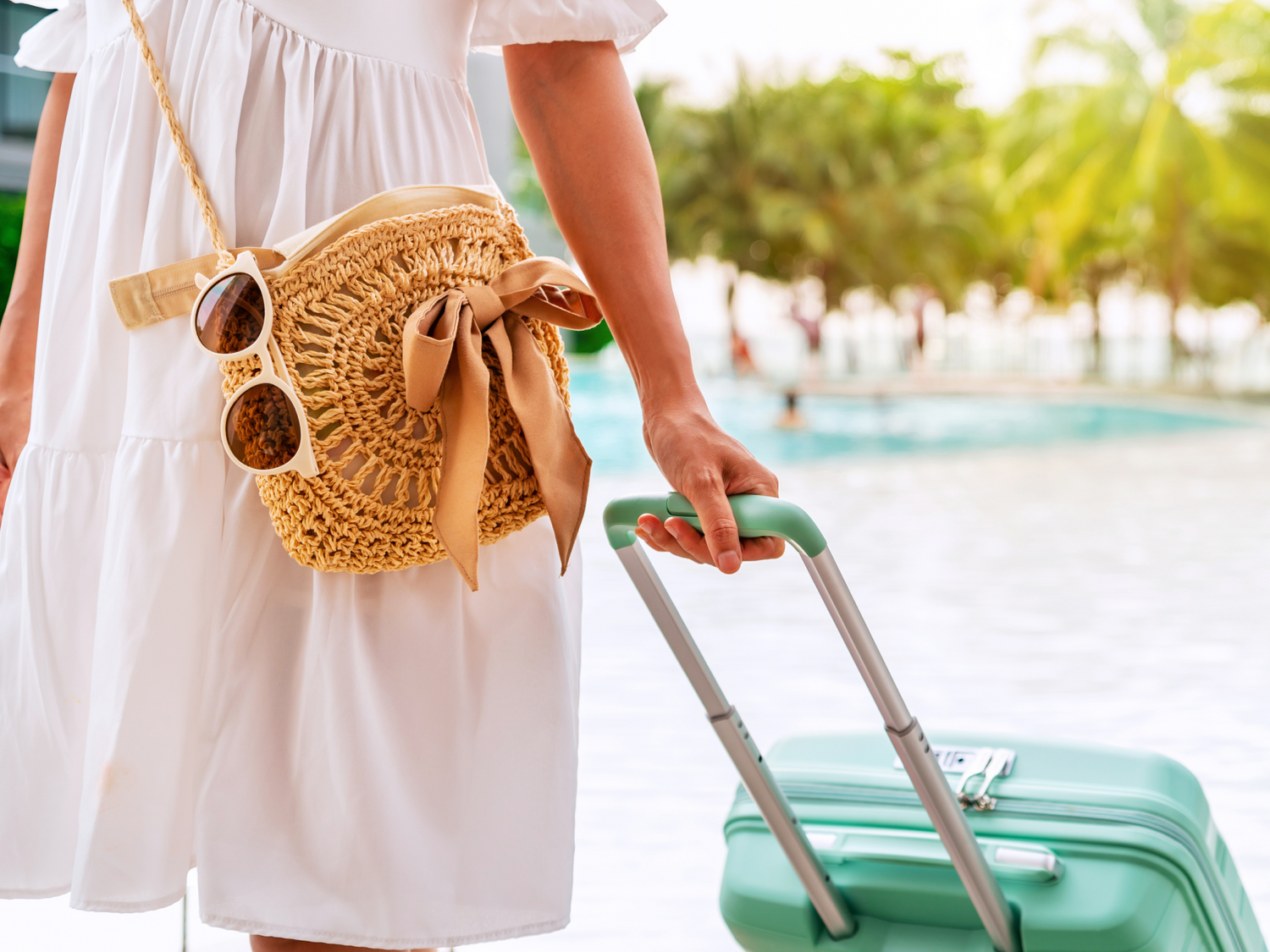Picture this: You're sitting in an airport terminal, watching your flight get delayed for the third time due to extreme heat. The air conditioning is struggling, you're already feeling dehydrated, and your legs are starting to feel heavy from sitting in the same position for hours. Sound familiar?
When temperatures soar, your heart works overtime. Hot weather forces your cardiovascular system to work harder to circulate blood and regulate body temperature]. Your blood vessels dilate to release heat, increasing blood flow to the skin, which can lead to increased heart rate and potential changes in blood pressure [1]. Add travel stress—whether you're cramped in an airplane seat, stuck in traffic, or dealing with delays—and your circulation faces even more challenges.
The good news? With the right strategies, you can keep your blood flowing smoothly no matter where your summer adventures take you.
1. Hydration Station: Your Blood's Best Friend
Dehydration is circulation's worst enemy, especially during hot-weather travel. When you're dehydrated, your blood becomes thicker and more prone to clotting. Heavy sweating, which helps cool your body, can lead to significant fluid loss that reduces blood volume, making your heart work harder to pump blood throughout your body.
Your hydration game plan:
- Drink plenty of water throughout the day, starting before you even begin traveling
- Choose foods with high water content like melons and cucumbers
- Limit alcohol and caffeine, which can dehydrate you
- Set reminders on your phone or use Ruby's water tracker feature to monitor your daily intake
Pro tip: The Ruby app's water tracker lets you log 8 oz, 24 oz, or 40 oz servings with quick-add buttons, making it easy to stay on top of your hydration goals even when you're on the move.
2. Dress for Success: Clothing That Helps Your Heart
What you wear can make or break your circulation during hot-weather travel. Tight, restrictive clothing can impede blood flow, while the wrong fabrics can trap heat and increase your body's workload.
Circulation-friendly travel wardrobe:
- Wear loose, light-colored, breathable clothing to allow air circulation and reduce heat absorption
- Consider compression stockings for long trips to help support blood flow in your legs, especially during flights or extended car rides
- Choose comfortable shoes that provide good support and cushioning
- Avoid tight waistbands, belts, or socks that can restrict blood flow
Compression stockings might not be the most fashionable choice, but they're incredibly effective at preventing blood from pooling in your legs during long periods of sitting.
3. Move It or Lose It: Staying Active While Traveling
Prolonged sitting is one of the biggest circulation challenges during travel. Avoid long periods of sitting and get up to walk around to prevent blood clots.
Simple exercises you can do anywhere:
- Ankle flexes: Point and flex your feet to activate your calf muscles
- Calf raises: Lift up onto your toes and lower back down
- Seated marching: Lift your knees alternately while seated
- Shoulder rolls: Keep your upper body circulation moving
For different travel modes:
- Flights: Walk the aisle every hour when the seatbelt sign is off
- Road trips: Stop every 1-2 hours for a 5-10 minute walk
- Train travel: Take advantage of the ability to move around more freely
The key is consistency—even small movements every 30 minutes can make a significant difference in maintaining healthy circulation.
4. Elevate to Activate: Simple Position Changes
Fighting gravity is exhausting work for your circulatory system, especially when you're sitting for extended periods. Elevating your feet while sitting can help improve blood flow and reduce swelling.
Elevation strategies for travelers:
- Use a carry-on bag or backpack as a footrest during flights
- Prop your feet up on the dashboard area during passenger car rides (safely, of course)
- Take advantage of reclining seats when available
- When resting at your destination, elevate your legs above heart level for 15-20 minutes
- This simple gravity assist helps your blood return more easily to your heart, reducing the strain on your circulatory system.
5. Cool Down, Flow Better: Temperature Control Strategies
High temperatures and humidity can cause more blood flow to the skin, potentially affecting blood pressure and putting additional strain on your cardiovascular system. Staying cool isn't just about comfort—it's about helping your circulation function optimally.
Creative cooling strategies for travelers:
- Use cooling towels, fans, or damp bandanas to stay comfortable
- Take cool showers or splash cold water on your pulse points when possible
- Seek shade whenever outdoors, especially during peak heat hours (11am-3pm)
- Create a DIY cooling station by placing ice in front of a small fan
- Keep a frozen water bottle to roll under your feet or place on pulse points
Airport/terminal tips: Many airports have cooling stations or quiet areas with better air conditioning—scout these out during layovers.
6. Smart Snacking: Foods That Support Circulation
What you eat and drink during travel can either support or strain your circulation. The right choices help maintain proper blood flow while keeping you energized for your journey.
Circulation-supporting travel foods:
- Water-rich fruits like watermelon, oranges, and grapes
- Nuts and seeds for healthy fats and magnesium
- Dark leafy greens (perfect for airport salads)
- Berries rich in antioxidants that support blood vessel health
What to limit:
- Excessive alcohol, which can dehydrate you and affect blood pressure
- High-sodium snacks that can cause water retention and swelling
- Sugary drinks that can cause energy crashes and don't provide lasting hydration
Surprising fact: Spicy foods can actually help cool you down by inducing sweat, which evaporates and cools your body. A little hot sauce on your travel meal might be just what your circulation needs!
7. Tech Check: Using Ruby to Monitor Your Travel Health
Modern technology makes monitoring your circulation and overall blood health easier than ever. The Ruby app provides valuable insights that can help you stay on top of your health during travel.
How Ruby supports your travel wellness:
- Circulation Score: Take a quick fingernail selfie to measure how fast blood is moving in your fingertips. A score over 75 is normal, while anything below 50 indicates poor circulation and warrants consulting your doctor
- Water Tracker: Use the hydration monitoring feature to ensure you're meeting your daily fluid needs
- Trend Monitoring: Track how travel affects your circulation over time
When to check your circulation:
- Before long trips to establish a baseline
- During extended travel days if you notice swelling or discomfort
- After arrival to see how your body responded to the journey
Ruby's circulation test can help you notice increases and decreases related to physical activity and environmental factors like heat and travel stress.
When Heat Becomes Dangerous: Recognizing Heat Stroke
While most circulation issues during hot-weather travel are manageable with proper precautions, it's crucial to recognize when heat becomes dangerous. Heat stroke is a medical emergency that requires immediate attention.
Warning signs to watch for:
- High body temperature (104°F or higher)
- Confusion or altered mental state
- Hot, dry skin (though sweating may still occur)
- Rapid, strong pulse
- Nausea or vomiting
- Headache
When to seek immediate medical attention:
- If you or someone you're traveling with shows signs of heat stroke
- If you experience chest pain, severe dizziness, or fainting
- If you have a pre-existing heart condition and notice unusual symptoms in the heat
People with heart conditions and those taking certain medications like beta-blockers, ACE inhibitors, or diuretics may be more vulnerable to heat-related complications and should take extra precautions [1].
Conclusion
Hot-weather travel doesn't have to derail your circulation or put your health at risk. By staying hydrated, dressing appropriately, moving regularly, and monitoring your body's responses, you can enjoy your summer adventures while keeping your blood flowing smoothly.
Remember that small, consistent actions make the biggest difference. Whether you're dealing with flight delays, traffic jams, or sweltering tourist destinations, these seven strategies will help you maintain healthy circulation and arrive at your destination feeling your best.
Ready to take control of your travel health? Download the Ruby app today to monitor your circulation and track your hydration. Your next adventure awaits—and now you're equipped to handle whatever the weather throws your way.
References
[1] Scripps Health. "Hot Weather and Heart Health: What to Know."




Leave a comment
This site is protected by hCaptcha and the hCaptcha Privacy Policy and Terms of Service apply.